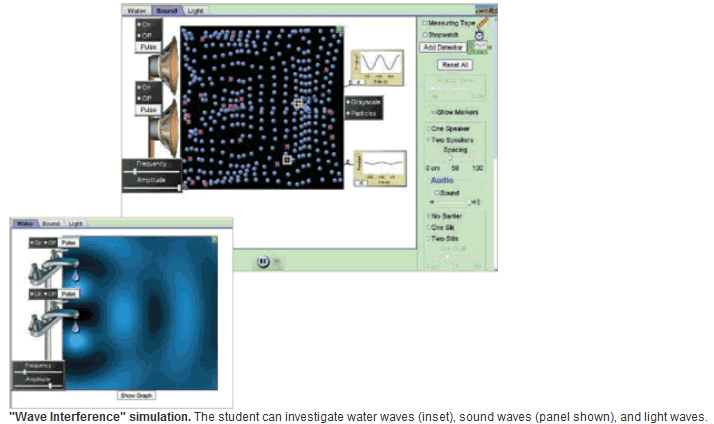|
|
|
|
|
|
|
News & Views item - November 2008 |
![]() Science Simulations Augment Lectures, Tutorials and Student Labs.
(November 3, 2008)
Science Simulations Augment Lectures, Tutorials and Student Labs.
(November 3, 2008)
A library of interactive computer simulations, the initiative of 2001 Nobel Laureate Carl Wieman is described in the October 31, 2008 issue of Science.
Professor Weiman, together with Eric Cornell of the National Institute of Standards and Technology and MIT's Wolfgang Ketterle received the Nobel Prize "for the achievement of Bose-Einstein condensation in dilute gases of alkali atoms, and for early fundamental studies of the properties of the condensates".
Now he and his collaborators, Wendy Adams and Katherine Perkins have developed a software suite they've named PhET (Physic Education Technology) comprising over 80 computer simulations predominantly of physical phenomena but it also includes "16 simulations on chemistry topics, as well as several simulations for math, biology, and earth science".
Each simulation "requires several months to create [and] has 10,000 to 20,000 lines of code". They simulations are now globally distributed and are aimed at students from grade school to those in upper-level university courses.

The authors find: "In PhET simulations, the visual display and direct interaction help answer students' question and develop their understanding. Animated graphics are used to convey how scientists visualize certain phenomena such as electrons, fields, and graphs... Interacting with the simulation helps users develop their own mental models and understanding of the science. This is particularly helpful for students of quantum mechanics", of which Richard Feynman once memorably commented: "I think I can safely say that nobody understands quantum mechanics."
The authors also sound a cautionary note: "We find that students are not able to make sense of the science in the simulation just from watching. They must interact actively with the simulation. Most of the learning occurs when the student is asking herself questions that guide her exploration of the simulation and her discovery of the answers. When students engage in such self-driven exploration, they learn better. For example, nonscience students with no prior knowledge of physics are able to provide quite good explanations of an electromagnetic wave after less than an hour playing with the "Radio Waves" simulation. (Even physics majors have a hard time explaining electromagnetic waves after a year of physics.)."
Another comment is that the simulations show certain benefits beyond student lab experiments in that students are 1) not occupied with trivia and 2) are not burdened with the fear of breaking the apparatuses. Nevertheless, they do not see their suit as a substitute for student labouratories, but rather an adjunct to them.
Finally: "Carefully developed and tested educational simulations can be engaging and effective. They encourage authentic and productive exploration of scientific phenomena, and provide credible animated models that usefully guide students' thinking."
______________________________________
The article can be found at: http://www.sciencemag.org/cgi/content/full/322/5902/682
And additional supporting online material is at: www.sciencemag.org/cgi/content/full/322/5902/682/DC1
The simulations are available from: http://phet.colorado.edu